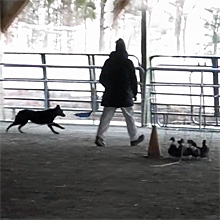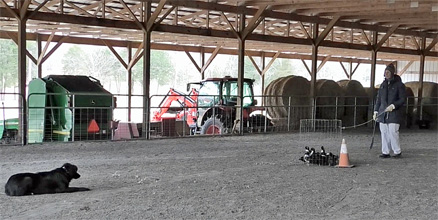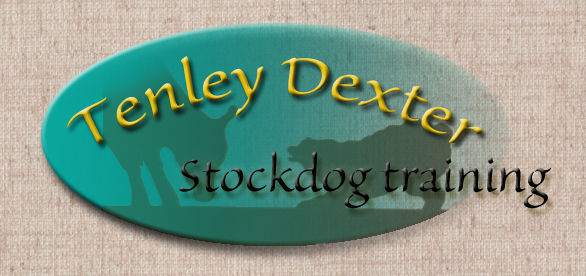| Step By Step Method | |
| Step 1. | Starting Your Puppy |
| Step 2. | Advancing Your Basics - Pace, Getting stock off a fence, Starting Outruns |
| Step 3. | Driving |
| Roxy's Progress At One Year of Age | |
| Questions & Possible Solutions | |
![]()
Advancing Your Basics
Working on Pace
In the the next working session with Roxy I require more space on her rebalancing movements. I often walk through the ducks at her and insist she give space to me before being allowed to rebalance. If she doesn’t give width to me, I simply block her, apply forward steps and pressure, when she does give to me, I allow her to go back around the stock and fetching continues. With the younger pup we encouraged flow and interest rather than how perfectly things are done. Now I break things down into more defined steps.
The most important aspect of fetching is to widen the pup out so she gets to the point of not disturbing the stock until she reaches balance, lifts and then fetches stock. Your long term goal is to make the dog understand that repositioning should not disturb stock, only the lift and the walk influence stock. If the handler only moves backwards while fetching, the pup will learn to overpush and not keep the stock in balance at the front of the handler.
Dogs only do three things while working stock…reposition themselves around the stock without influencing it (flanks, outruns), move stock (walking up) and stop (down, stand). Everytime the handler changes balance, the pup is actually doing a tiny outrun, lift and fetch. It’s the handler’s job to convey to the pup the three distinct steps every time they occur which is often during a walkabout. Many dogs don’t have a true understanding of the separation of these three things as a result of the inability of the handler’s training process to convey this to the dog.
I introduce fetching on the fenceline to work the pup’s understanding of where the ducks belong as she fetches them to me. As long as the ducks are at my front, my core, as I walk backwards along the fence, I keep going but if the ducks pass me either from their desire to go to the draw or the pup overpushes, I stop walking, let the pup go to the head and then bring them back on the correct side of me and then resume fetching. My eyes, shoulders and tool follow the pup as she goes to fix balance and also on the return trip before I back up to resume the fetch. If the ducks go off to the side of me but not really past my back, the pup is allowed to go out and bring them back to the fence in front of me. I continue walking backwards while the pup “covers” and rebalances the ducks to create space for the ducks to nestle in the correct location when they return.
I also introduce a little corner exercise where I scoot a duck out and let the pup cover it and bring it back. Eventually this will become my “watch it” or “hold ‘em” command in the pup's future training video.
All these exercises can be accomplished with broke sheep as well.
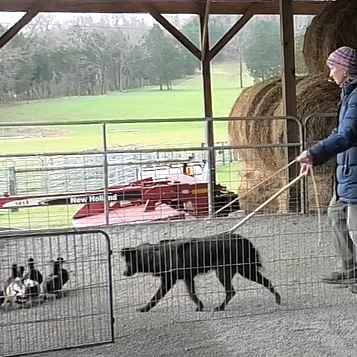
As the pup progresses, I will raise my expectations of the preciseness of the balance position to me and her pace. I work pace on the fenceline because it is easier than out in the open. I ask the pup to walk up and keep the stock to me but not push it past me. I hold my side of the stock so the pup will feel the pressure bubble/flight zone around the stock. If the stock has no pressure on the front side, the dog will never learn to feel the bubble of the stock. Dogs learn to feel the bubble in a fetch because there is some amount of handler pressure, either natural or contrived, on the opposite side of the stock.
If the pup doesn’t respond to the flight zone by easing up on their pressure/pace, they might need to be verbally corrected with a gruff noise or ahh from the handler to slow their pace and not push the stock past the handler. A dog can also be downed if lesser corrections fail to achieve that goal. Some dogs will naturally slow their pace down as they feel the pressure of the stock back on them since the stock is responding to the handler’s pressure and no commands or corrections noises are necessary. You can also use the down command before the stock passes you to create the correct picture for the dog to experience. If the stock does pass the handler, the pup should be allowed to go around it, bring it back to the correct side of the handler and the exercise resumes just like in the first video. The trick is to make sure the dog isn’t tight on either their path to rebalance or the return trip and settles back in the pocket behind the stock or else the dog will immediately push the stock past the handler.
Using ducks rather than very broke sheep is a more realistic scenario of how stock reacts to the presence of a handler as ducks are easily repelled by handlers. Broke sheep often run to a handler and try to stay with them for safety from the dog and give dogs a very false picture of their part of the work. I use Call ducks to start my pup as they tend to be less aware of the handler’s pressure but still don’t come to the handler unless the dog makes them. As the training proceeds, I use harder and harder ducks.
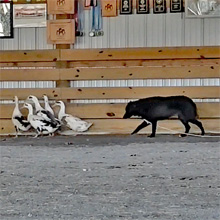
![]()
Getting Stock Off a Fence
Here’s a helpful handling technique to teach the pup to take the ducks off a corner or fence and not lose them back to the fence. Many older dogs could benefit from this exercise as well. Getting ducks off a fence and keeping them off can be a challenge when there is a strong draw or the dog is overflanking when trying to get them off the fence. The dog may initially succeed in taking the ducks off the fence or corner but overflanks causing the ducks to roll around the dog and get right back on the fence. The handler can show the dog a simple exercise where the handler catches the dog before it overflanks via the line and block of the tool and quickly turns the dog to cover the roll of the ducks back to the fence. After showing the dog a couple of times, they get very handy in performing this maneuver themself as they see the sense of it and won’t lose the control of the ducks.
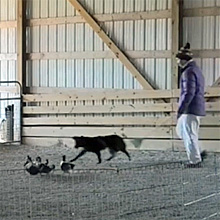
![]()
Starting Outruns
Once my pup is doing ABCs and fetching the stock well, I’ll start some small outruns. The criteria for starting outruns are:
|
As soon as I can leave a pup and it will stay while I walk closer to the stock, I start little outruns.
Everything remains calm and patient during Roxy’s first outrun session. Pup errors simply give the handler the chance for more repetitions. I leave the pup at the other end of the area and I walk close to the ducks to make sure she’s wide enough at the top of the outrun to get all the ducks off the fence. I try to not let her rush when she arrives at the fenceline to give the ducks time to leave and go towards the open area. If the dog rushes as she gets up there, she’s telling the ducks she’s not going around and they will split with some remaining on the fence or traveling very far down the fenceline before they come off.
Dog broke sheep willingly leave a fence or a corner as the dog approaches no matter how incorrect the dog’s movement. They give movement away for free and perhaps even fetch to the handler for free. While very broke stock is good for beginner dogs and inexperienced handlers, long term use of this type of stock gives both a false impression of their skills.
Ducks are more honest if the dog isn’t correct when trying to get them out of a corner or off a fence. Ducks teach a dog to take their time and allow the ducks to come off a fence or out of a corner without rushing. If the dog’s flank movement isn’t truly telling the ducks that he/she is going around them, the ducks will split leaving some ducks behind or run down the fence. I love duck work with young dogs as it can be done in relatively small areas with the handler fairly close to the pup with both getting an honest view of their progress.
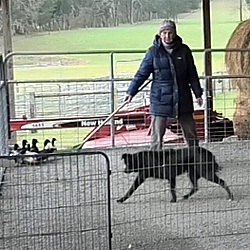
Roxy’s next outrun practice happened to be in the lovely warmer weather of Florida where I gave a clinic. We were able to work outside and there were lots of distractions around the working area which was a great test of her focus. I introduced a hoop to hold the ducks off the fence since students were present to lift it when I asked Roxy to walk up after she had gotten to the topside of the stock and downed. Having the stock off the fence helps practice the top of the outrun which I wasn’t able to do when the ducks were against the fence. The hoop also helps break the process down into three parts; the Outrun gets Roxy to the back side of the stock, the Lift is her initial contact to start the ducks and then the Fetch brings the stock to me. The purpose of the outrun is for the dog to move around the stock without disturbing them. In the small area the pup really can’t get wide enough to not disturb the ducks but the use of a hoop helps to keep the stock still until the pup lifts them and helps separate the three distinctive steps for the pup.
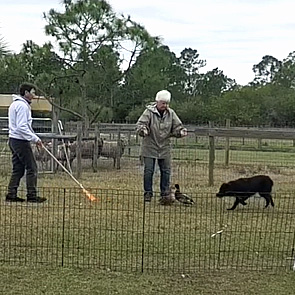
I’ve got enough control of Roxy now and she’s got enough control of herself that she’s graduated to the open space of the arena. While I position Roxy further off her stock, I still position myself closer to the stock than the dog and still shadow her as she makes her way around the hoop making sure the top of the outrun stays properly wide. I’m not as worried about how she leaves as I am about how she arrives giving the hoop a wide berth so as to not disturb the stock. One must be careful as they shadow the dog to not get their position or their tool in front of the dog’s eye which might cause the dog to slow, reverse or stop the outrun. Those that have lunged a horse will find shadowing a dog on an outrun a similar skill. Getting a smooth flow of the outrun might take a lot of practice for beginner handlers. Observe how I wait for the pup to get to a certain point on her outrun before I even move and rotate my shoulders and tool so I keep the flow.
